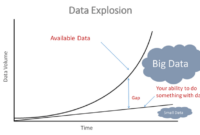Real-time data storage solutions play a crucial role in the efficient management of data for businesses in today’s fast-paced digital landscape. From enhancing data accessibility to ensuring seamless operations, these solutions are at the forefront of modern data management strategies.
Overview of Real-time Data Storage Solutions

Real-time data storage solutions refer to systems and technologies that enable the immediate and continuous storage of data as it is generated or updated. These solutions are designed to capture, process, and store data in real-time, allowing organizations to access up-to-date information for various applications and analytics.
In modern business operations, real-time data storage plays a crucial role in facilitating informed decision-making, enhancing operational efficiency, and enabling timely responses to changing market conditions. By storing data in real-time, organizations can gain valuable insights, identify trends, and detect anomalies quickly, giving them a competitive edge in today’s fast-paced and data-driven environment.
However, managing real-time data efficiently comes with its own set of challenges. The volume, velocity, and variety of data generated in real-time can overwhelm traditional storage systems, leading to issues such as data latency, data loss, and scalability limitations. Organizations need to implement robust storage solutions, data management practices, and infrastructure to effectively handle real-time data streams and ensure data integrity and reliability.
Types of Real-time Data Storage Solutions
Real-time data storage solutions come in various types, each with its own set of benefits and limitations. In this section, we will compare and contrast different types of real-time data storage solutions such as in-memory databases, distributed file systems, and cloud storage.
In-Memory Databases
In-memory databases store data in the main memory of a computer, allowing for faster access and retrieval compared to traditional disk-based databases. This type of solution is ideal for applications that require real-time processing of large volumes of data, such as financial trading platforms or real-time analytics tools. However, the main limitation of in-memory databases is the cost associated with maintaining large amounts of memory.
Distributed File Systems
Distributed file systems are designed to store and manage large volumes of data across multiple nodes in a network. Examples include Hadoop Distributed File System (HDFS) and Google File System (GFS). This type of solution is commonly used in big data applications where fault tolerance and scalability are crucial. Distributed file systems are well-suited for industries like e-commerce, social media, and scientific research.
Cloud Storage
Cloud storage solutions offer scalable and cost-effective options for storing real-time data in the cloud. Services like Amazon S3, Google Cloud Storage, and Microsoft Azure Blob Storage provide reliable storage infrastructure with high availability and durability. Cloud storage is widely used in industries such as healthcare, finance, and media, where data needs to be accessible from anywhere at any time.
Key Features to Look for in Real-time Data Storage Solutions

When considering real-time data storage solutions, there are several key features that are crucial to ensure optimal performance and efficiency. These features play a significant role in the overall functionality and reliability of the storage system.
Scalability
One of the most important features to look for in real-time data storage solutions is scalability. The ability to scale the storage system as data volume grows is essential to accommodate increasing data demands without compromising performance. A scalable storage solution allows for seamless expansion and addition of storage resources as needed.
Reliability
Reliability is another critical feature in real-time data storage solutions. The system must be highly reliable to ensure that data is consistently available and accurate. This includes features such as data redundancy, failover mechanisms, and data recovery options to prevent data loss and downtime.
Data Replication and Data Consistency
Data replication is essential for real-time data storage solutions to ensure data availability and fault tolerance. By replicating data across multiple nodes or locations, the system can maintain data consistency and protect against data loss in case of system failures. Data consistency ensures that data is accurate and up-to-date across all storage nodes.
Data Compression and Encryption
Data compression and encryption are crucial features in real-time data storage solutions to optimize storage capacity and enhance data security. Data compression reduces storage space requirements by compressing data before storage, while data encryption protects sensitive information from unauthorized access. Both features contribute to efficient data management and protection.
Real-time Analytics Capabilities
Real-time analytics capabilities are increasingly important in conjunction with data storage to extract valuable insights from data in real-time. By integrating analytics tools with the storage system, organizations can analyze data on-the-fly, gain actionable insights, and make informed decisions promptly. This feature enhances data utilization and enables proactive decision-making based on real-time data trends.
Implementation and Best Practices

Implementing real-time data storage solutions in an organization requires careful planning and execution to ensure optimal performance and data integrity. It also involves overcoming common challenges that may arise during the implementation process.
Steps for Implementing Real-time Data Storage Solutions
- Assess the organization’s data storage needs and requirements to determine the most suitable real-time data storage solution.
- Choose a reliable vendor or provider that offers a solution that aligns with the organization’s goals and objectives.
- Develop a clear implementation plan that Artikels the steps involved, timelines, and responsibilities of each team member.
- Test the real-time data storage solution in a controlled environment before full implementation to identify any potential issues or compatibility issues.
- Train employees on how to use and manage the real-time data storage solution effectively to ensure smooth integration into daily operations.
Best Practices for Optimizing Performance and Ensuring Data Integrity
- Regularly monitor and analyze the performance of the real-time data storage solution to identify any bottlenecks or areas for improvement.
- Implement data backup and disaster recovery plans to protect against data loss and ensure data integrity in case of unforeseen events.
- Utilize encryption and access controls to secure sensitive data and prevent unauthorized access or data breaches.
- Optimize data storage processes to ensure efficient use of resources and minimize storage costs.
Common Challenges Faced During Implementation and How to Overcome Them, Real-time data storage solutions
- Integration issues with existing systems and applications can pose a challenge during implementation. To overcome this, conduct thorough compatibility testing and work closely with IT teams to resolve any integration issues.
- Data migration challenges, such as transferring large volumes of data to the new real-time data storage solution, can be addressed by breaking down the migration process into smaller, manageable tasks and prioritizing critical data sets.
- Ensuring data consistency and accuracy across different systems and databases may require implementing data validation processes and regular audits to identify and resolve discrepancies.
In conclusion, Real-time data storage solutions offer a comprehensive approach to handling data in real-time, providing businesses with the tools they need to stay competitive in a data-driven world. By embracing these solutions and implementing best practices, organizations can optimize their data storage processes and drive success in their operations.
When it comes to big data processing, one cannot overlook the importance of Hadoop Distributed File System (HDFS). This robust system allows for efficient storage and retrieval of large datasets across distributed clusters.
For those looking for alternatives to traditional relational databases, NoSQL databases offer a flexible and scalable solution. These databases can handle unstructured data with ease, making them ideal for modern data management needs.
When discussing data storage solutions for businesses, Distributed data storage is a key concept to consider. By distributing data across multiple nodes, organizations can ensure high availability and fault tolerance.



